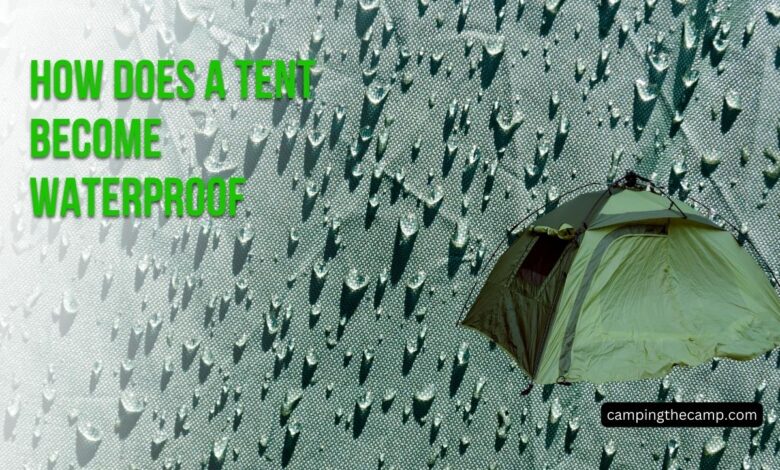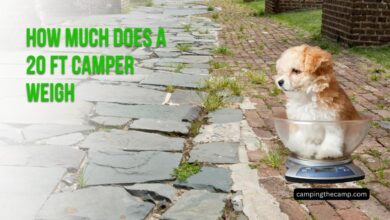How Does a Tent Become Waterproof: Understanding the Process

Camping in the great outdoors often means dealing with the uncertainty of weather. Rain, in particular, can turn an enjoyable trip into a soggy mess if you don’t have adequate shelter. Thankfully, today’s tents are engineered to be water-resistant and keep you comfortable no matter the conditions.
Waterproof ratings measure how well a tent’s fabric and seams hold up against moisture. Just because a tent is deemed “waterproof” doesn’t necessarily mean it’s completely impenetrable, but it should keep you and your gear dry in most wet weather situations. High-quality materials, specialized coatings, and meticulous construction come together to create reliable, long-lasting waterproofness.
In this article, we’ll break down the key elements that allow modern tents to shed rain, dew, and groundwater. We’ll also look at how waterproof ratings work, features that affect waterproof performance, and tips for keeping your tent’s water-resistant properties going strong. With the right knowledge, you can find a tent that will stand up to the storm and keep you high and dry.
What Makes a Tent Waterproof?
For a tent to be effectively waterproof, every component needs to come together to create a barrier against moisture. The main factors that contribute to water resistance include:
- Tent fabric: The type of fabric and denier rating (thread thickness) determine breathability and water repellency. Coated nylon and polyester are common water-resistant tent materials.
- Fabric coating: A chemical treatment is applied to the fabric to make it more impermeable. Polyurethane (PU) is the most common waterproof coating.
- Seam tape: Taped seams seal the needle holes created during manufacturing to close gaps where moisture could enter.
- Waterproof floor: A bathtub-style floor keeps groundwater from seeping up into the tent interior.
- Rainfly: This separate outer layer acts as an extra watertight shield when used in rainy conditions.
- Water-resistant zippers: Special zippers don’t allow water to pass through the teeth.
When all of these elements work together cohesively, they create an integrated shelter that prevents moisture from entering from above, below, or through fabric joints. Now let’s look at each aspect in more depth.
Tent Fabric
The type of fabric is the first line of defense when it comes to a tent’s waterproof functionality. Modern tents use woven fabrics coated on one or both sides to repel moisture. Nylon and polyester are the most common choices due to their strength, light weight, and weather-resistant properties.
Denier (D) is the unit of measurement for the density of the fibers used in the fabric. Higher denier fabrics tend to be more durable and better at repelling water. Most decent-quality tents range from 30D to 75D fabric or higher.
In addition to the raw fabric, a chemical application is needed to make the material effectively waterproof. Next, we’ll look at how special coatings create a moisture barrier.
Waterproof Coatings
The tent fabric alone won’t keep water out without an extra layer of protection. This is achieved by coating the fabric with a durable water repellent (DWR) finish such as polyurethane (PU), silicone, or polyvinyl chloride (PVC).
Polyurethane is the most common coating used in tent production. It bonds to the fabric fibers to reduce surface tension and cause water to bead up and roll off instead of soaking in. This impermeable barrier keeps moisture from passing through even under rainfall or high humidity.
Over time, the effectiveness of the DWR coating can diminish with regular use and exposure to the elements. Weathering from sunlight, abrasion, and compression break down the coating. A depleted DWR finish leads to leaking seams, sagging fabric, and reduced waterproof performance.
Most waterproof tents need to be retreated every year or two to renew the DWR coating. Spray-on treatments are available to help restore water beading to the fabric. Talk to the tent manufacturer for specific re-waterproofing recommendations.
Sealed Seams
While the coated fabric provides the first line of defense, tent seams often need reinforcement to eliminate gaps. Unprotected stitching holes can allow moisture to seep through, creating leaks along the seams.
To seal these vulnerabilities, the seams are covered with tape specially formulated to bond with the fabric and coatings. PU, polyester, or nylon tape creates a continuous waterproof barrier along the length of the seam.
Some ultra-high-end tents feature taped seams throughout the entire structure for unrivaled protection. More affordably priced models often just tape the most critical seams prone to leaking.
Double-stitched or bound seams add an extra measure of strength and reinforce high-stress areas. But this doesn’t necessarily make the seams waterproof unless they are also taped.
Bathtub Floors
While the tent roof shields from rain above, a waterproof floor prevents ground moisture from seeping in from below. Bathtub-style floors extend up the lower tent walls by several inches to deflect splashback and runoff.
The floor is usually made from heavier, more puncture-resistant fabric with a durable polyurethane coating. Welded, not sewn, seams create a seamless moisture barrier along the floor perimeter.
Some tents have a detachable rain fly that extends down over the bathtub floor for added runoff protection. Staking down the edges also helps seal out groundwater during heavy rain.
Vents located up on the tent walls prevent splashback from entering but allow interior condensation to escape. An optional footprint ground cloth adds another moisture barrier against dew and ground moisture.
Rain Fly Layer
For wet weather protection, most tents incorporate an outer rainfly layer that shields the inner tent. This detachable top acts as an extra barrier that raindrops can’t penetrate.
The rainfly is made of coated ripstop nylon or polyester with TPU coating. When extended out and staked down, it creates an awning-like vestibule space to protect the tent entrance. Full-coverage rainflys drape all the way to the ground on all sides for maximum waterproofing.
Vents in the rainfly promote air circulation to cut down on condensation. Some models have removable panels to expose mesh windows and allow more light and visibility.
During fair weather, the rainfly can be partially removed to expose the mesh tent body for increased ventilation. Just make sure to re-attach it when wet conditions return.
Waterproof Zippers
Zipper openings are one of the most vulnerable spots for moisture intrusion. Standard zippers can separate and leak water through the teeth.
Water-resistant zippers are designed with tighter tolerances so the teeth interlock more securely. Anti-corrosion treatments also help the zipper slide and resist sticking when wet.
Storm flaps seal off the zipper by covering it with an extra layer of coated fabric. Fastening the storm flap down over the zipper provides additional protection against wind-driven rain.
Inside tent seams are often sealed with binding tape behind the zipper track as well. This acts as a drainage gutter to channel moisture away rather than allowing it to leak through.
Waterproof Ratings
So how waterproof is “waterproof” when it comes to tents? Manufacturers use different ratings to quantify the level of water resistance. These specifications measure the strength of the fabric coating and performance under simulated testing.
One of the most common ratings is millimeters (mm). This refers to the height of the column of water the fabric can withstand before moisture begins to penetrate. For example, 1,500mm indicates the fabric can hold up under a 1.5-meter tall column of water.
General tent guidelines:
- 1,500mm to 3,000mm offers good water resistance for casual camping
- 3,000mm to 5,000mm provides greater wet weather protection and performance in heavy rain
- 10,000mm or higher means ultra-reliable waterproofing even in stormy conditions
Keep in mind real-world use doesn’t always replicate laboratory testing. Dirt, UV damage, wear and tear all degrade waterproofness over time. But higher mm ratings do indicate more durable, long-lasting performance.
Other Helpful Waterproof Features
In addition to the major tent components we’ve covered, other small details contribute to reliable waterproofing including:
- All-weather guy lines and tighteners to pull the rainfly awning taut.
- Liquid-sealing seams or applying seam gum during repairs.
- Mesh storage pockets and gear lofts to avoid touching wet tent walls.
- Storm flaps covering all zipper and vent openings.
- A mud mat for the door to wipe shoes and keep groundwater out.
Look for designs with overlapping rainfly coverage, gloved vent openings, and lots of stake-out loops as well. The more coverage, the better the tent will shed wind-driven downpours.
Caring for Your Tent
To get the longest life from your waterproof tent, some regular maintenance is required. Here are a few tips for keeping your tent performing like new:
- Let the tent dry out completely between uses and don’t store it wet.
- Keep it clean by brushing off dirt and avoiding setting up on mud.
- Apply re-waterproofing spray if the fabric stops beading water.
- Seal any new holes or tears immediately with seam tape.
- Don’t over-tension the fabric when pitching.
- Check for signs of UV damage and retire the tent if needed.
With proper care and precautions, a high-quality tent can maintain excellent waterproof performance for many seasons before needing replacement.
Waterproof Ratings Explained
To help you choose a tent with sufficient wet weather protection, here’s a more in-depth look at the different waterproof rating systems:
- Millimeters (mm): As discussed above, this indicates how tall of a water column the fabric can withstand before leaking, i.e. 1,500mm, 3,000mm.
- Hydrostatic Head (HH): A similar measurement to mm rating but specifically refers to the fabric’s water pressure resistance. Typically given in millibars.
- Waterproof vs. Water Resistant: “Waterproof” indicates fabric with a hydrostatic head of 1,500mm or higher. “Water resistant” means it holds up to 1,000mm.
- DWR Rating: Refers to the level of durable water repellent coating applied to the fabric. Ranges from poor to excellent.
- ATP Rating: Measures resistance to water penetration on a scale of 1 to 5. Level 5 indicates the most waterproof performance.
The mm and HH ratings offer the most helpful specifications for assessing true waterproof capability. But the general terminology and DWR ratings can also provide clues to the tent’s wet conditions suitability.
Frequently Asked Questions
How is the floor of a tent made waterproof?
A: Bathtub-style floors use heavier, coated ripstop fabric extended several inches up the walls. Welded seams and polyurethane coatings help create a pool-like floor that contains moisture.
Do all the seams need to be taped?
A: Critical seams prone to leaking should have tape applied for full waterproofing. Higher-end tents tape every seam, while more budget models just tape a portion.
How do micro-tears affect tent waterproofing?
A: Tiny holes from abrasion, stress, or UV damage allow moisture to penetrate the fabric. These micro-tears reduce water resistance over time until the tent is retreated.
Can you re-waterproof an old tent?
A: Yes, you can restore lost water repellency by applying a DWR spray coating. Clean it first and check for any cracks or holes needing repair to maximize results.
Why does condensation sometimes form inside a tent?
A: The moisture comes from internal evaporation and your breath, not from leaks. Keeping vents open helps reduce condensation buildup, along with using a rainfly.
Should a tent be stored wet or dry?
A. Always allow your tent to dry fully before storing it away. Storing it wet can lead to mildew growth and fabric degradation.
Conclusion
When you’re planning trips and choosing gear, don’t underestimate the importance of waterproofing in a tent. Advanced fabrics, coatings, construction techniques, and components all work together to provide reliable shelter from the elements. Look for ample waterproof ratings, taped seams, rainfly coverage, and bathtub floor design in a tent engineered for wet conditions.
With the information from this article, you now have a better understanding of how modern tents keep you high and dry. Just be sure to care for your tent properly between adventures so it maintains its water-shedding capabilities for many seasons. The right tent will protect you from the storm so you can comfortably enjoy your experience in the great outdoors.




